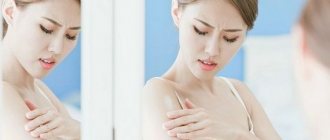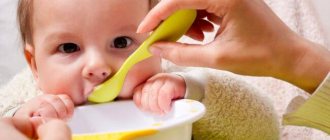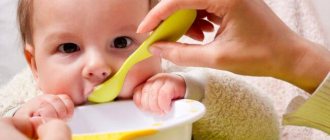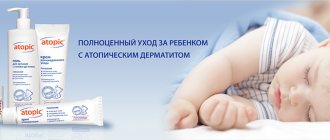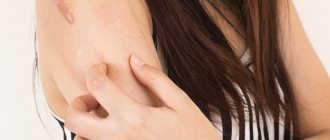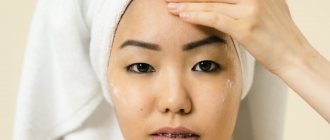Atopic dermatitis (another, now rarely used name for this disease is diffuse neurodermatitis , can be considered a type of eczema ) is a chronic allergic dermatitis that develops in those who are predisposed to allergies. In most cases, the appearance of neurodermatitis occurs in the first years of life and, as a rule, is accompanied by relapses. Moreover, most patients get rid of atopic dermatitis in childhood. But at least 10% of the total number of people suffering from this disease continue to experience it in adulthood.
The number of people suffering from neurodermatitis is constantly increasing in our time, as new allergenic factors that provoke the disease appear, associated with environmental pollution, the development of the food additive industry, household chemicals, social globalization, etc.
Atopic dermatitis. Treatment
Treatment for neurodermatitis is complex, so it is convenient to undergo it in our multidisciplinary clinic, equipped with the latest diagnostic and treatment equipment.
If you have been diagnosed with neurodermatitis, treatment should include consultations with a gastroenterologist or otolaryngologist. It is necessary to solve digestive problems and eliminate foci of chronic infection of the ENT organs. The patient also needs to follow a regimen and diet.
In severe forms of atopic dermatitis, treatment may sometimes require the patient to stay in a hospital, but is more often carried out on an outpatient basis.
Antihistamines, hormonal drugs, and physiotherapeutic procedures are prescribed.
Also, for neurodermatitis, treatment includes the use of ointments and creams with antipruritic and exfoliating effects.
It is important to understand that dermatitis indicates dysfunction of the immune system, and its exacerbation, in turn, contributes to a decrease in immunity and often provokes viral and fungal infections.
In this regard, timely diagnosis of dermatitis is of great importance for preventing relapses of the disease, as it allows for a timely course of prevention.
In our clinic you can undergo all the necessary laboratory methods for studying the allergic status and immune system for diseases such as psoriasis , vitiligo, neurodermatitis (atopic dermatitis), eczema.
1 Excilite µ system
2 Excilite µ system
3 Excilite µ system
We treat patients with long-term neurodermatitis using modern techniques and innovative equipment. Thus, laser treatment of dermatitis allows achieving stable long-term remission of the disease.
1 Excilite µ system
2 Excilite µ system
3 Excilite µ system
In addition, laser treatment of dermatitis allows the patient to stop taking steroid (hormonal) drugs. We use a new generation excimer laser, Excilite µ, which is effective in the treatment of psoriasis, vitiligo, atopic dermatitis, alopecia, and eczema. The treatment is easily tolerated by patients; the procedures have virtually no contraindications.
The material was prepared with the participation of a specialist:
Auxiliary basic therapy of atopic dermatitis in children
In 2002, an international expert group on atopic dermatitis (AD) came to the following conclusion: “AD in childhood and adulthood appears to be a single disease, although in the future genetic subtypes with different expression patterns may be identified” [1 ]. Experts emphasize a characteristic feature of the course of AD: since in such patients the barrier function of the skin is impaired and itching occurs, therapy takes a symptomatic focus - moisturizing the skin and relieving itching. Today there is no doubt that external therapy is pathogenetically substantiated and absolutely necessary for every patient suffering from AD. However, recommendations for external therapy, including skin care and the correct use of local drugs, have not yet received adequate support from practicing doctors, and therefore from patients. Moreover, modern knowledge and achievements in the treatment of AD are sometimes of little use in practice and are reduced mainly to the prescription of topical corticosteroids (TCS) and/or symptomatic drugs in the form of various dermatological prescriptions.
In a recently published review, one of the leading scientists, Prof. D. Leung called moisturizing and softening the skin the “key” point of AD therapy [2]. What explains the fundamental importance of external therapy for blood pressure? First of all, the need to restore and maintain the integrity of the skin barrier, the violation of which is one of the cardinal signs of AD, entailing increased transepidermal water loss, as well as the development of increased sensitivity of the skin to various irritants and colonization of the skin by Staphylococcus aureus [2, 3].
Auxiliary basic therapy
In the adopted consensus document on AD, skin hydration and the use of moisturizers are classified as adjuvant basic therapy, the use of which is an absolutely necessary element in the treatment of atopic dermatitis [1]. Experts emphasize the importance of individual, adequate selection of the necessary skin care products, depending on personal preferences, the patient’s age and type of blood pressure. These can be agents with different mechanisms of action - occlusive, moisturizing, emollient, as well as stimulators of protein recovery [1].
An important aspect of auxiliary basic therapy should be especially noted, which is that due to a violation of the barrier function of the skin and its dryness, moisturizers/emollients are used even during periods when there are no symptoms of the disease [1, 8–10].
It is known that in patients with AD, the same inflammatory cells that infiltrate atopic areas are found in the skin that is not involved in the pathological process; As for the manifestations of skin hyperreactivity, they also do not differ in any way in different places [10, 11]. It has also been shown that dry skin, accompanied by transepidermal water loss, leads to increased systemic absorption of TCS [12].
In addition, atopic skin, due to its hyperreactivity, has the following characteristic feature: its condition changes depending on fluctuations in air temperature, stressful situations, after eating certain foods or for other reasons [1, 6, 13]. Undoubtedly, external treatments also affect the condition of the skin. And such changes in the skin after the application of drugs, such as burning, increased itching, hyperemia, can be associated by patients or doctors with the use of a particular drug, which often entails its withdrawal. In fact, the cause of such skin manifestations may be the above-mentioned exogenous factors, and doctors should remember this when observing the patient over time, and, if necessary, test him for drug tolerance. We should not forget about the possibility of developing allergic contact dermatitis even to the main anti-inflammatory drugs for treating AD - topical corticosteroids and/or topical calcineurin inhibitors [14–17].
Regular use of emollients/moisturizers is extremely important for the skin. This has been confirmed by a number of randomized studies.
It should be noted that the terms “emollients” and “moisturizers” are not equivalent concepts [18]. As is known, dry skin is associated with a violation of its barrier function, which occurs not only in AD, but also in ichthyosis and contact dermatitis. However, xerosis (dryness) and impaired skin barrier function are characterized by various biochemical, physicochemical and morphological changes. The study of the features of these processes underlies the development of a new direction in the treatment of skin diseases - the pharmaceutical and cosmetic industry.
It has been proven that the effectiveness of moisturizers depends on their dose (moisturizers should be used regularly in sufficient quantities), skin pH, and patient compliance [18–21]. After application, the ingredients included in moisturizers (emulsifiers, antioxidants, preservatives) remain on the surface of the skin, are absorbed and subsequently metabolized, or disappear from the skin. In addition to the moisturizing effect, these products also have other properties. Thus, emulsifiers affect the barrier function of the skin, and ceramide-containing lipid components reduce transepidermal water loss through the skin. In general, moisturizers make atopic skin less sensitive to irritants and contact allergens [18].
Recently, to reduce dry skin in patients in whom the use of emollients and moisturizers has proven ineffective, a new line of drugs that can affect the extracellular membrane of the epidermis has been developed - the so-called ceramide-dominant emollients [19, 20]
The fact that emollients/moisturizers have pharmacological properties has been confirmed experimentally. Thus, in experiments on mice it was shown that the application of white paraffin or cream with ketomacrogol leads to an increase in antimitotic processes in the skin [22]. Emollients containing white paraffin also have a vasoconstrictor and atrophogenic effect on the skin (of course, to a lesser extent than TCS) [23]. Another study confirmed the anti-cyclooxygenase capacity of emollients, suggesting their anti-inflammatory effect [4].
However, even before prescribing emollients/moisturizers to a patient with AD, it is necessary to teach him to follow certain skin care rules.
AD requires special skin care in any phase of the disease (exacerbation, remission). As mentioned above, even in the absence of clinical symptoms of AD, it is necessary to continue to carry out general skin care, the important components of which are skin hydration and regular use of moisturizers.
General skin care rules must be followed. Regardless of age, patients with AD need daily 15–20-minute water procedures (shower, bath), which clean and moisturize the skin, prevent infection, and improve the penetration of drugs into the skin [2, 24, 25]. Bathing water should be cool and dechlorinated. The latter is achieved by leaving it in a bath for 1–2 hours, followed by warming or adding boiling water. You can also use water that has been purified using special filters.
Often the appearance of dry skin and exacerbation of blood pressure are associated with swimming in pools with chemically treated water, as well as other water procedures. It has been proven that the skin of patients with AD is more sensitive to the effects of residual chlorine contained in tap water compared to the skin of healthy individuals [26]. In addition, exposure to residual chlorine itself may play a provoking role in the development and exacerbation of AD. When visiting swimming pools, some patients note a deterioration in their skin condition, although others, on the contrary, may benefit from swimming [3]. In any case, immediately after swimming in pools, patients with AD are advised to use mild cleansers to remove chlorine or bromine, followed by a moisturizer.
When swimming:
- Do not use washcloths or rub the skin;
- It is advisable to use high-quality detergents with a neutral pH of 5.5 (exclude soap!);
- after bathing, pat the skin dry (do not wipe dry!) with a towel;
- To prevent the effect of evaporation, emollient/moisturizing skin care products are applied to still damp skin, especially to areas of extreme dryness.
Moisturizers
Most studies support the effectiveness of daily moisturizing therapy in patients with AD [4, 24, 25]. The combined use of such drugs with anti-inflammatory drugs (TCS, topical calcineurin inhibitors) is especially important.
In children and adults with mild to moderate AD, J. Hanifin et al. conducted a comparative study of the effectiveness of topical application of a moisturizing cream, used 3 times a day, in combination with TCS - 2 times a day (group 1), and monotherapy with a hormonal drug (group 2) [21]. After 3 weeks of treatment, significant clinical improvement was achieved in the 1st group of patients compared to the 2nd group. In addition, more than 95% of all study participants expressed a desire to receive combination therapy.
In another study, an emollient cream was added to hydrocortisone 2.5% cream administered once daily; This treatment regimen was compared in terms of effectiveness with the double use of TCS alone [27]. The emollient has been shown to reduce the need for TCS, and its regular use helps prevent exacerbations of blood pressure. However, in 2/3 of children over 1 year of age, monotherapy with emollients did not help prevent exacerbations of blood pressure.
The effectiveness of auxiliary drugs was clinically and morphologically confirmed in a study by S. Chamlin et al., who added an emollient with a predominance of ceramides to the standard therapy of a group of children with “persistent resistant blood pressure” [28]. By the end of 6–12 weeks, all patients showed clinical improvement in blood pressure symptoms. In addition, extracellular laminar membranes were found in the ultrastructure of the stratum corneum, which were almost completely absent initially.
Another study using a ceramide-dominant emollient (atopalm multilayer emulsion in combination with TCS) found a decrease in skin atrophy and a decrease in skin pH compared with hormonal drug alone [20].
Even earlier, R. Marks reported that in adult patients with hand dermatitis who used moisturizers for more than 1 month, clinical improvement (as assessed by the severity of blood pressure using the SCORАD index) was comparable to that observed in the group of patients who used highly active TCS - 0.025% betamethasone valerate [23].
A very interesting study was conducted by R. Ainley-Walker et al., who studied the effectiveness of various external agents by applying them to two symmetrical areas of the affected skin [13]. The study included 82 patients (66 of them children) who used medium- and high-potency TCS, as well as emollients. The following features of external therapy were identified: for example, when comparing the effectiveness of light class TCS and an emollient, TCS was effective in 10 cases out of 17, in five cases the clinical effectiveness of the drugs was the same, and in two cases the emollient was considered even more effective than a topical corticosteroid . In another comparison group, in three patients, the emollient in terms of therapeutic effectiveness was almost no different from TCS of average activity.
However, these conclusions still need to be confirmed in randomized clinical trials [2, 3, 22].
What medications are advisable to use in patients with AD?
For skin care, there are various products from the medical and cosmetic series such as “Mustela StelAtopia” (MUSTELA), “Aven” (AVENE), “A-DERMA”, “Topicrem” (NIGY CHARLIEU), “Vichy” ( VICHY), “Uriage” (URIAGE), “Bioderma” (BIODERMA), etc. [29, 30].
When using skin care products, you should take into account the age of the patient (it is known, for example, that the skin of children has a more neutral pH, is more permeable, they have a higher intensity of skin respiration, etc.), the composition of the drugs and indications for their use.
Let's conduct a comparative analysis of some products intended for skin care with AD, taking into account such important parameters as: completeness of the series; age from which the product can be used; the ability of the drug to create a protective film on the skin, as well as inhibit the growth of microorganisms; intensity of skin hydration; the ability to restore the lipid layer in the skin; anti-inflammatory effect; active component of the drug, etc.
Complete series: Hygiene / Skin cleansing / Care for blood pressure - Mustela StelAtopia, Aven laboratory, A-Derma line of Ducray laboratories, Vichy laboratory.
Softening/moisturizing: Topicrem, Lipikar-Balm, Lipikar emulsion; Lipidiosis 1, 2, 3; Nutrilozh 1, 2; Topicrem; Mustela StelAtopia cream-emulsion, soothing cream A-Derma.
Phases of the disease:
- exacerbation - cream Atoderm R.O. zinc, Mustela StelAtopia Bath Oil, Lipikar Bath Oil, Trixera line of Aven laboratory, Egzomega line of A-Derma gamma;
- remission - Topicrem, Mustela StelAtopia cream-emulsion, Atoderm cream, Uriage Cu-Zn-gel, Aven Trixera, A-Derma Egzomega, Iktian cream from Ducray laboratories.
Age from which the drug can be used:
- 0 - adult patients with AD - Uriage Cu-Zn-gel, Uriage Cu-Zn-cream; Topicrem, Atoderm, Aven, A-Derma;
- 0–15 years - Topicrem, Mustela StelAtopia, Aven, A-Derma;
- after 2 years and adults - Lipikar, Aven, A-Derma.
The creation of a protective film is characteristic of many products, with the exception of Atoderm mousse and Uriage Cu-Zn gel.
Skin moisturizing is characteristic of many products, with the exception of Pruured cream and Uriage Cu-Zn cream.
Restoration of lipids in the skin is characteristic of many products, with the exception of Atoderm R.O. Zn cream, Atoderm mousse, Uriage Cu-Zn cream.
Anti-inflammatory action is characteristic of many products, with the exception of Topicrem.
Suppression of the growth of microorganisms is typical only for Mustela StelAtopia (all types), Atoderm R.O. Zn cream, Dermalibur cream of the A-Derma line, Sicalfat cream of the Avene line.
The main active component of the products:
- vegetable oil - in Mustela StelAtopia;
- mineral oil, shea butter in small quantities - in Lipikara;
- 2% urea and glycerin - 9.5% - in Topicrem;
- Aven thermal water in the Aven line;
- colloidal oat extract Realba in A-Derm;
- β-sitosterol in Atoderm R.O. zinc.
The Mustela StelAtopia cosmetic line is designed to care for atopic skin using sunflower oil distillate, obtained using a unique method through molecular distillation, which occurs under extreme vacuum (103 mm Hg) and temperature leading to the evaporation of organic components with high molecular weight - vitamins, steroids, polymers, fatty compounds, etc. The active ingredients of the drug include: 90% - essential lipids (linoleic and oleic triglycerides), 5% - phytosterols, 1% - a-tocopherol (90% natural vitamin E) , ceramides, softening components. The patented sunflower oil distillate has a chemical structure that is capable of being involved in lipid metabolism. As is known, dry skin in AD leads to changes in the epidermal barrier and is associated with a violation of the lipid content in it, so it is very important to use drugs that can affect the lipid balance of the skin.
Mustela Stelatopia Cleansing cream is a soap-free product that contains sunflower concentrate, glycerin, castor oil, glycine. Use for daily washing in the bath or shower, rinse with water. Protects and softens the skin.
Mustela StelAtopia Bath oil contains 90% emollients, including sunflower oleodistillate, bisabolol, phospholipids. Ideal for dry atopic skin: the fat base makes the skin soft; relieves inflammation, relieves itching. Add 2-3 capfuls to the water per bath. After washing, do not rinse off; pat the skin dry with a towel.
Mustela StelAtopia Cream emulsion contains sunflower concentrate, essential fatty acids, ceramides, sitosterol, sucrose derivatives, and emollient components. Restores key skin lipids, relieves inflammation. Apply to clean, dry skin of the face and body 2-3 times a day.
Thus, in children with blood pressure the following is used:
- during exacerbation of blood pressure - Mustela StelAtopia Bath Oil + Mustela StelAtopia Cream-emulsion;
- during the period of remission of blood pressure - Mustela StelAtopia Cleansing cream + Mustela StelAtopia Cream-emulsion.
There are also other effective skin care products for AD patients.
Atoderm mousse, super-nourishing soap Atoderm is a soap-free cleanser used for daily hygiene of dry and atopic skin. Moisturizes, soothes, softens the skin.
Atoderm R.O. zinc cream is a soothing, antipruritic and moisturizing cream for dry, irritated skin during periods of exacerbation of blood pressure.
Atoderm cream is a compensating, protective and moisturizing cream for skin care outside of exacerbation.
The Egzomega line of the A-Derma dermocosmetic laboratory is specially designed for the care of atopic skin. The main active components of the line are Realba oat extract and a complex of essential Omega 6 fatty acids. The anti-inflammatory and softening properties of Realba oats reduce irritation and itching, and Omega 6 essential fatty acids quickly penetrate deep into the membrane phospholipids and intercellular cement of the stratum corneum, restoring its homogeneity and tightness, block inflammation and suppress the synthesis of prostaglandins and leukotrienes.
The Egzomega line consists of three products.
- Cleansing foaming shower oil can be used simultaneously as a face and body gel, as well as a cleansing softening bath by dissolving 2 caps of product in water;
- Egzomega cream and Egzomega milk are used daily in comprehensive dermatological care for atopic skin of infants, children and adults. The liquid texture of the milk makes it easy to apply to large areas of the skin.
Lipikar Sindet is a liquid cleanser with pH = 5.5. Contains: shea butter - 1% (reduces skin dryness by restoring the hydrolipid film on the surface of the epidermis); glycerin - 2% (provides rapid hydration of the upper layers of the epidermis); emollient components - 8% (soothe irritated skin); anti-lime components - 0.3% (neutralizes lime water).
Lipikar oil is a soothing lipid-replenishing bath product. Dissolve in water or apply directly to skin in the shower. Coming into contact with water, Lipikar oil restores the damaged hydrolipidic film of extremely dry skin, protecting it from the dehydrating and irritating effects of salts contained in tap water. Lipikar contains shea butter (5%) and active components of the epidermis: fatty acids, similar in structure to those that are absent or significantly reduced in people with dry skin; sterols that relieve skin irritation and have a healing effect.
Lipikar-balm is the first lipid-replenishing balm for the face and body that does not cause clogging of pores, and the first “oil-in-water” emulsion containing oleosomes. Oleosomes are microdroplets of oil containing lipophilic active components that have a high affinity for the surface layers of the epidermis (due to the latter, a pronounced and long-lasting moisturizing effect of the drug on the skin is achieved). In addition to oleosomes, Lipikar includes: shea butter - 20% (provides natural replenishment of skin lipids, has a wound-healing and softening effect); glycerin - 10% (moisturizing component); rapeseed oil - 5% (has a softening effect); thermal water LA ROCHE-POSAY (soothes and softens the skin, has a wound-healing effect).
Lipikar emulsion is a moisturizing softening emulsion for face and body. Contains: α-bisabolol (intensively moisturizes and softens the skin); allantoin (prevents the occurrence of lichenification); shea butter (restores the hydrolipidic film on the surface of the epidermis); thermal water LA ROCHE-POSAY (soothes and softens the skin, has a wound-healing effect).
Ceralip is a restorative lip cream. Contains: shea butter (replenishes the lack of fatty acids on the surface of the skin of the lips); wax (provides additional protection for the skin of the lips from external influences of adverse factors); does not contain preservatives and is odorless.
A series of pharmaceutical cosmetics from the VICHY laboratory for the care of atopic skin includes: Lipidioz 1 milk, Lipidioz 2 cream, Lipidioz hand cream, Nutrilozhi 1 and Nutrilozhi 2 face cream, Lipidioz stick for lips.
Lipidiosis 1 is a moisturizing milk for dry body skin. Contains: active hydrofixatives (urea + ammonium lactate), glycerin, shea butter, VICHY thermal water. Hydrofixators retain moisture in the skin and limit the disorganization of lipid plates, which helps to moisturize the skin for 24 hours. The use of Lipidioz 1 ensures the disappearance of the feeling of skin tightness and cracks.
Lipidiosis 2 is a liquid cream for very dry skin of the torso. Contains: glycerin, mineral oil, olive oil, avocado oil, currant seed oil, shea butter, VICHY thermal water. The supply of prestructured lipids allows you to restore gaps in the intercellular cement and optimally increase the protective function of the skin. As a result of using the cream, flaking and itching of the skin are eliminated, cracks heal, and the skin becomes smooth and soft.
Lipidiosis is a restorative product for the care of dry and cracked lip skin. The unique composition of the drug allows you to protect the red border of the lips from ultraviolet rays, promotes the healing of cracks, nourishes and softens the skin of the lips.
Nutrilozhi 1 is a cream for dry facial skin based on a patented sphingolipid, created using oleosome technology. Sphingolipid is an exogenous precursor of lipids that restores the disrupted natural process of reproduction of the skin's own lipids and the barrier function of the epidermis. The oleosome is the newest galenic transport form for the transfer of lipophilic active components, providing protection, deep penetration and prolonged action of lipophilic components (sphingolipids). In addition, Nutrilozhi 1 contains: patented sphingolipid - N-(2-hydroxyhexadecanoyl sphinganine), ceramides, tocopherol, cholesterol, glycerin, disodium EDTA, apricot oil, VICHY thermal water. Thanks to oleosomal technology, sphingolipid penetrates into the deep layers of the skin and restores the skin's ability to produce its own lipids. Apricot oil, glycerin, essential fatty acids soften and nourish the skin. Thermal water has a soothing effect on the skin and enhances its natural protective properties. Nutrilozhi 1 cream restores the barrier properties of the epidermis by increasing the skin's level of its own ceramides, softens and nourishes the skin, making it smooth and soft.
Nutrilozhi 2 is a cream for very dry facial skin based on a patented sphingolipid, created using oleosome technology. The composition and mechanism of action of Nutrilodge 2 and Nutrilodge 1 are similar. Additionally contains: beeswax, petroleum jelly, karite oil, thanks to which the nourishing and softening effect on the skin is enhanced.
Another French company, Laboratoires Nygy-Charlieu, has specially developed and produces a hypoallergenic, highly effective moisturizing emulsion Topicrem.
Topicrem is a water-oil emulsion based on glycerin (long-term moisturizes the skin), urea 2% (keratolytic agent), which can be used for dry and flaky skin, including in newborns. Topicrem quickly restores the water-fat balance on the surface of the skin, effectively softens and eliminates the feeling of tightness that occurs with severe dry skin [29, 30].
To eliminate dry skin, they also use Bepanten, F-99, Drapolen, Children's creams, Rosa, Glutamol cream (Infarma CJSC), which contains the substance glutamol isolated from sea mollusks, vitamins A, E, petroleum jelly, glycerin, emulsifiers, etc. ... [25, 29, 30]. For the same purpose, Unna cream continues to be widely used. External therapy also includes such dermatological and symptomatic agents as anti-inflammatory drugs in the form of zinc, naphthalan, tar; ointments or gels containing antihistamines (Fenistil-gel, Psilo-balm).
In the practice of treating AD, phytocreams are also often used; products created according to recipes from Chinese doctors are especially popular [33].
An extremely important and interesting study was recently conducted by N. Ramsay et al. among children with AD whose parents reported the use of phytocreams with a positive effect [34]. It was proposed to conduct a chemical analysis of the cream, which was used by 19 patients. Determination of hydrocortisone, clobetasone butyrate, betamethasone valerate and clobetasol propionate in the composition of the product was carried out by high-performance liquid chromatography. 24 samples of the cream were examined. Seven samples contained propionate in clobetasol (in particular, 20% dermovate), 13 out of 17 samples of cream from unknown manufacturers also contained various TCS. None of the parents suspected that the cream they were using contained a corticosteroid, including strong and very strong ones. In this regard, it should be noted that this fact requires the immediate adoption of measures in the field of licensing herbal creams and improving the system of informing the population about the possible dangers posed by non-traditional methods of treatment.
Abroad, particularly in the UK, the use of compresses with emollients and/or TCS is widely practiced - occlusive circular dressings that are applied over the drug [35, 36].
From the standpoint of evidence-based medicine, the effectiveness of using emollients/moisturizers for AD is understandable, while the effectiveness of using compresses and other types of dressings in patients with AD has not been established [37].
Sometimes, when using emollients and moisturizers, patients experience minor side effects, mainly burning [32].
Typically, emollients and moisturizers are used several times in the morning and throughout the day, and always after a bath and shower, while topical steroids are prescribed mainly at night.
Since AD is characterized by a change in the balance between water and lipids on the skin surface, which leads to the development of clinical symptoms such as dryness and itching of the skin, the need for auxiliary basic therapy is absolutely obvious.
Modern research has proven the important role of skin hydration and the administration of moisturizers in the acute and chronic phases of AD. The literature even describes cases where moisturizers and TCS were equally effective in patients with AD. In general, skin hydration and moisturizers significantly increase the effectiveness of complex therapy for AD and the quality of life of such patients. In addition, moisturizing preparations have a kind of preventive effect even before the appearance of pronounced symptoms of exacerbation of the disease and can significantly reduce the amount of drug therapy [13, 18, 21].
At the same time, auxiliary basic therapy does not replace drugs with anti-inflammatory effects (TCS, topical calcineurin inhibitors).
Modern practice shows that the importance of using moisturizers in the treatment of AD is greatly underestimated throughout the world. Perhaps the main reason for this is a lack of information among doctors themselves, or low compliance on the part of patients. Thus, a recent survey showed that of 77% of children suffering from AD, to whom specialists prescribed emollient ointments, only 21% used them immediately after water procedures [32].
The task of the treating physician and nursing staff is to educate patients with AD and their caregivers about the importance of regular hydration and cleansing of the skin, followed by the application of a moisturizer. Only after this the patient is recommended to use anti-inflammatory drugs (TCS, topical calcineurin inhibitors).
For questions regarding literature, please contact the editor.
D. Sh. Macharadze , Doctor of Medical Sciences Children's City Clinic No. 102, Moscow
